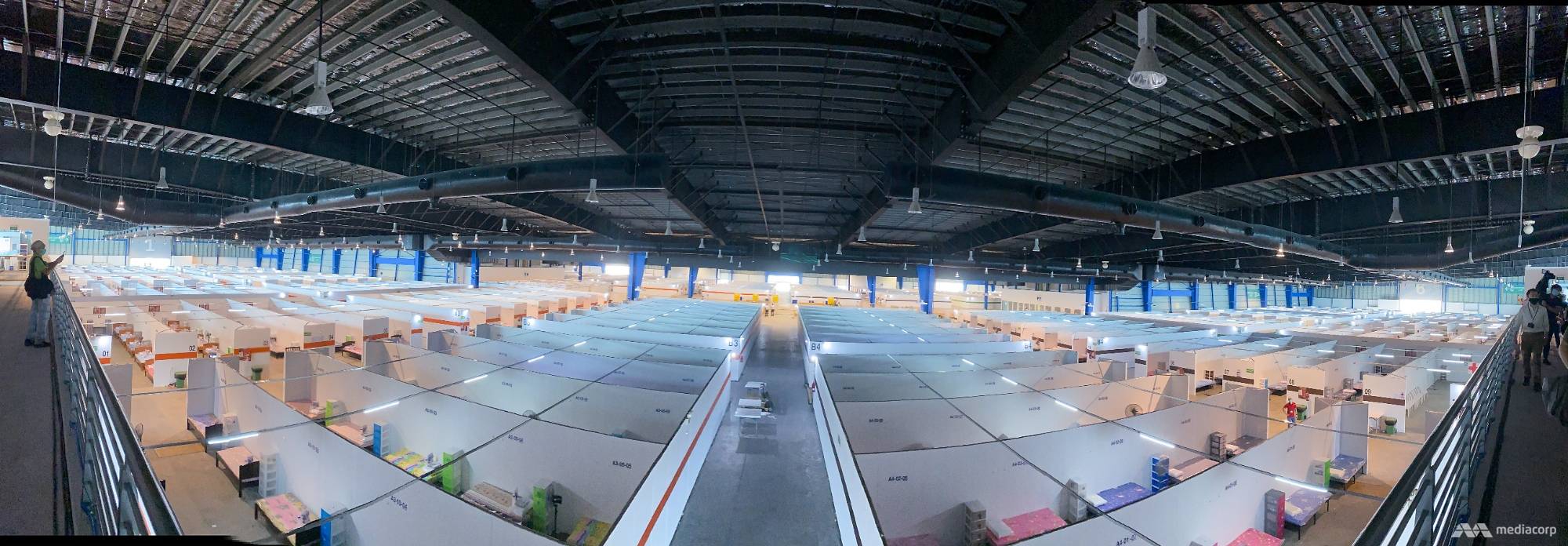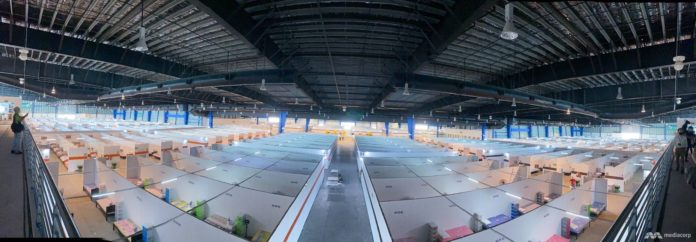SINGAPORE: It is known as home to the biennial Singapore Airshow, but the sprawling Changi Exhibition Centre (CEC), has been repurposed into a community isolation facility to house recovering COVID-19 patients and early patients displaying mild symptoms of the disease. It accepted its first 50 or so patients on Saturday (Apr 25).
Most of the patients it is expected to house are foreign workers.

The sprawling Changi Exhibition Centre (CEC), has been repurposed into a community isolation facility – the third of its kind in Singapore. (Photo: Gaya Chandramohan)
A man carries supplies to furnish rooms in the CEC facility, a day before the first patients arrive. (Photo: Gaya Chandramohan)
The remodelled indoor facility can accommodate about 2,700 patients. There is an option to increase its capacity to up to 4,400 patients by expanding into the outdoor area, which is currently undergoing construction.
The outdoor area, which is still under construction, will be able to house another 1,700 patients. (Photo: Gaya Chandramohan)
The CEC is the third community isolation facility in Singapore, joining D’Resort NTUC in Pasir Ris and the Singapore Expo. D’Resort NTUC in Pasir Ris is able to take in about 500 people, while the Singapore Expo facility can take double that capacity.
CNA got a behind-the-scenes look at the CEC facility in a media tour on Friday, a day before the first patients were admitted, and got a glimpse of technology used to minimise the risk of infection.
An overhead view of the beds lined up in partitioned rooms for COVID-19 patients at the Changi Exhibition Centre isolation facility. (Photo: Gaya Chandramohan)
Rooms for COVID-19 patients being prepared at the Changi Exhibition Centre. (Photo: Gaya Chandramohan)
The CEC facility’s operations are managed by Mandarin Oriental Singapore and healthcare services are provided by Raffles Medical Group. It was set up by a task force comprising nine MINDEF-affiliated organisations along with partners such as the Dormitory Association of Singapore, Experia Events and Surbana Jurong.
THE THREE ZONES
For the safety of medical workers and other essential staff, the combined indoor and outdoor areas of the 108,000 sq metre CEC facility have been demarcated into three different zones – red, yellow, and green.
The green, yellow, and red zones of the 108,000 sq metre Changi Exhibition Centre isolation facility. (Image: MINDEF)
Patients reside in the red zone and are free to move about the space which comprises of their living areas, toilets, laundry facilities and a medical centre. Only authorised personnel such as medical workers and essential maintenance crew donning personal protective equipment (PPE) are allowed to enter the red zone.
Inside the CEC’s red zone, patients will have access to toilet, shower and laundry facilities. (Photo: Gaya Chandramohan)
Clear signs are posted in every sector of the Changi Exhibition Centre isolation facility to help guide patients to amenities. (Photo: Gaya Chandramohan)
The yellow zone serves as a barrier of sorts to the red zone, where personnel and their PPE are subjected to strict checks before they are allowed to come into contact with the patients. Upon exiting the red zone, all personal belongings and equipment will be disinfected in the yellow zone before these can be brought into the green zone.
The green zone is for personnel to work and rest when they are not inside the red zone. No PPE is required within this area.
PATIENT MANAGEMENT AND MEDICAL CARE
The facility will see two shifts per day, with 20 to 30 doctors, nurses and healthcare assistants from Raffles Medical Group during each shift. They will provide round-the-clock care for patients through teleconsultations, sick parades, and ward rounds.
Medical personnel simulate taking a patient’s vitals. (Photo: Gaya Chandramohan)
As the number of patients in the facility increases, the manpower for healthcare professionals is also expected to scale up.
To help minimise the risk for cross-contamination, consultations via teleconsultation stations placed around the red zone will be used to diagnose patients who present persistent symptoms. For serious cases, patients can do physical consultations with a doctor at the on-site medical centre.
In case of an emergency, patients will also have access to emergency buttons located in various sectors to alert the operations and medical centres. An emergency hotline is also available 24 hours a day, seven days a week for patients to call.
In the event that a patient’s condition deteriorates significantly, the medical centre is equipped to stabilise patients before they are transferred to Changi General Hospital.
In case of an emergency, medical buggies stationed around the CEC help doctors to transport patients from their rooms to the medical centre quickly. (Photo: Gaya Chandramohan)
Patients are also required to practice routine monitoring of their health through the blood pressure machines and pulse oximeters placed in every sector of the living area.
They will have to conduct health checks on their own three times a day and submit information such as their temperature, blood pressure, and pulse reading through an app. This data will then be automatically submitted to the medical team for routine monitoring.
Swabbing stations have also been set up on site to test patients for COVID-19. Upon word from the Ministry of Health (MOH), patients who have tested negative and are deemed fully recovered will be transferred out of the CEC facility to be discharged.
LIVING INSIDE THE RED ZONE
When patients arrive at the CEC, they will be received by security officers to verify identification details before being escorted to check-in and undergo a medical check-up.
When patients first arrive at the CEC facility, they will have to check-in and undergo a medical check-up. (Photo: Gaya Chandramohan)
A medical worker at the Changi Exhibition Centre community isolation facility. (Photo: Gaya Chandramohan)
Patients with symptoms will be tagged with a red wristband, while recovering patients will have white wristbands.
Upon arriving, patients will be handed a white wristband or a red wristband to indicate their health status. (Photo: Gaya Chandramohan)
In addition to a welcome video, patients will also receive a “welcome kit” with an orientation information sheet, toiletries, washing detergent, hand sanitiser, oral thermometer and face masks.
Each patient will receive a welcome kit. (Photo: Gaya Chandramohan)
Patients will live with others in a partition room that has eight to ten beds, power sockets, Wi-Fi access, fans and storage cabinets. Every single patient will have a 6 sq metre area to themselves, which is bigger than the 4 sq metres they normally get in dormitories.
Items like toiletries, hand sanitiser and face masks are included in each patient’s welcome kit. (Photo: Gaya Chandramohan)
Each partition room has eight to ten beds, power sockets, Wi-Fi access, fans and storage cabinets. (Photo: Gaya Chandramohan)
To help keep patients occupied, they will be added to a Telegram channel whose name translates to “Second Home” in Bengali, Tamil and Mandarin. It will broadcast messages in those languages and in English and help involve them in daily virtual programmes such as Fitness By Your Bed and Afternoon Online Matinees. Patients will have free access to programmes on Mediacorp’s MeWatch.
The bed spacing within rooms takes in consideration safe distancing requirements. (Photo: Gaya Chandramohan)
Through the use of roving telepresence robots that are remote-controlled, volunteers who can speak the various Indian languages will also engage with patients virtually.
Patients will be provided with three Halal meals daily, with a selection of Indian, Bangladeshi, Chinese and vegetarian cuisines.
Currently, five ST Engineering STrobo Tug robots have been deployed to the Changi Exhibition Centre isolation facility and there are plans to progressively increase this to 12 robots. (Photo: Gaya Chandramohan)
ST Engineering STrobo Tug robots will help to distribute food to the various sectors of the red zone at the Changi Exhibition Centre isolation facility. (Photo: Gaya Chandramohan)
To minimise physical contact between facility staff and patients, meals will first be delivered into an air pressure chamber in the yellow zone before ST Engineering STrobo Tug robots distribute food to the various sectors of the zone.





